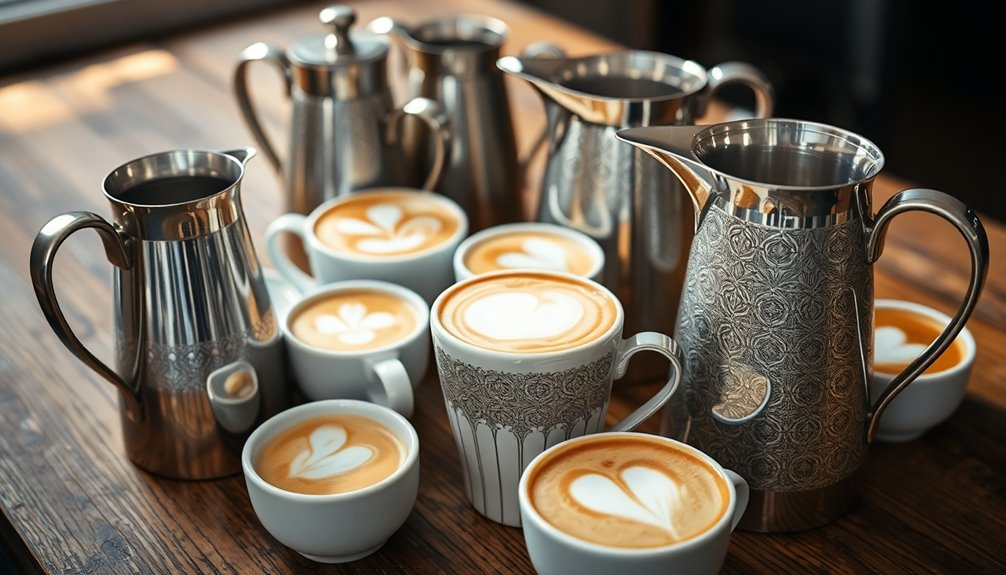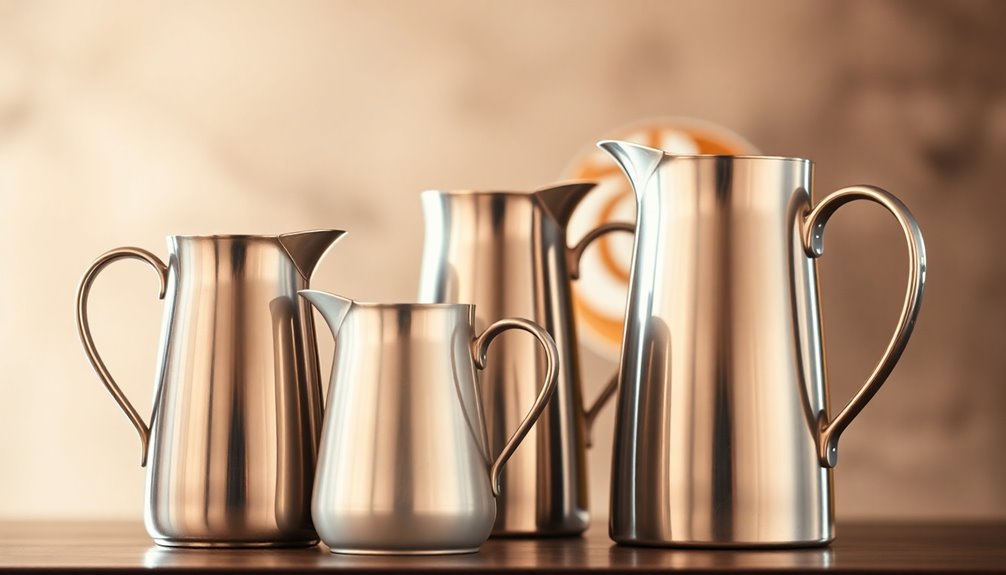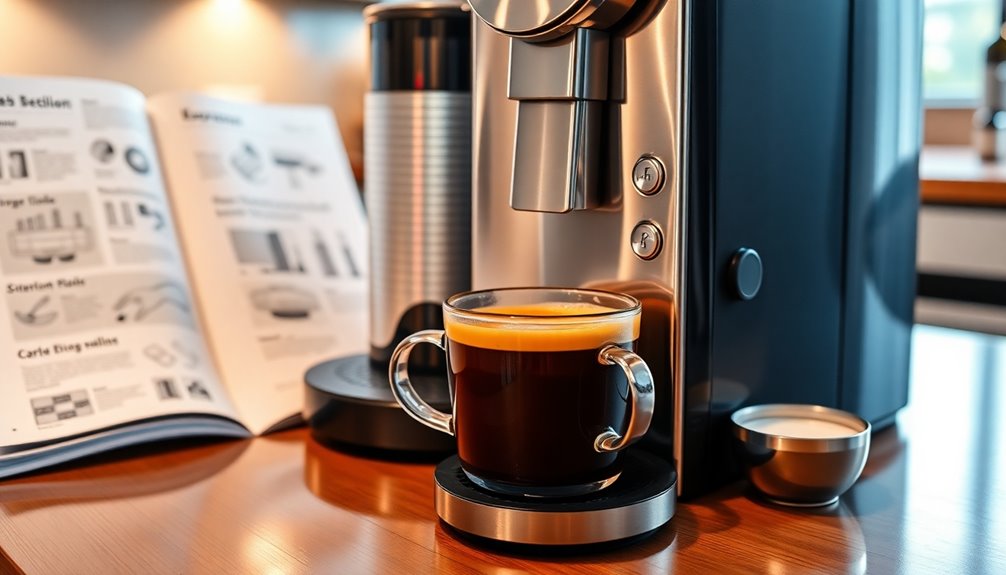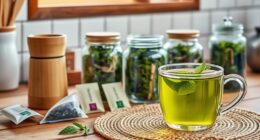To elevate your latte art, picking the right milk frothing pitcher is vital. Look for durable 304 stainless steel for heat retention and choose a size that suits your drink—20 ounces is a popular choice. Pay attention to the spout shape; pointy spouts help create intricate designs, while wider ones lend bold lines. Practice proper handling techniques, like filling the pitcher a third of the way with cold milk and positioning the steam wand just below the surface. For maintenance, regular cleaning and descaling are essential for peak performance. You'll discover even more tips and tricks as you explore further!
Key Takeaways
- Choose high-quality 304 stainless steel pitchers for durability and optimal heat retention during frothing.
- Select the right size pitcher, ideally 20 ounces, to accommodate frothing expansion and ensure consistent results.
- Look for ergonomic handles and pointed spouts for better control and intricate latte art designs.
- Maintain your frothing pitcher by regularly cleaning and descaling to ensure optimal performance and longevity.
- Experiment with swirling techniques and steam wand positioning to achieve velvety microfoam for perfect espresso drinks.
Materials and Construction

When choosing a milk frothing pitcher, the materials and construction play an essential role in your frothing experience.
Opt for stainless steel, as it's durable and retains heat effectively, keeping your milk at the ideal temperature. Look for high-quality 304 stainless steel, which meets food safety standards. Thicker pitchers (around 1mm) enhance heat retention, while thinner options (0.5mm) may be less durable. Additionally, the choice of pitcher material can significantly impact the overall frothing quality. The effectiveness of frothing can also be influenced by the brewing method you use to prepare your coffee.
If you prefer a non-stick surface, consider Teflon-coated pitchers that make cleaning a breeze. Some models combine stainless steel with Teflon for added benefits.
Pay attention to design features like a flared shape for frothing and a narrow spout for precise pouring, ensuring you create beautiful latte art with ease.
Size and Capacity

Choosing the right size and capacity for your milk frothing pitcher is essential for achieving the best results with your latte art.
Milk frothing pitchers typically range from 12 to 32 ounces, with the 20-ounce pitcher being the most popular choice for both home and professional use. If you're making smaller lattes or cappuccinos, opt for a pitcher around 14-15 ounces.
For larger drinks or multiple servings, a 20-21 ounce pitcher is ideal. Remember, the pitcher should hold double the milk needed, considering the expansion during frothing. The 20 oz pitcher is particularly recommended for making 12 oz lattes.
Look for pitchers with internal volume markings to help you measure accurately. Align your pitcher size with your espresso cups for a seamless latte art experience.
Design and Shape

The design and shape of your milk frothing pitcher play an essential role in mastering latte art. A pointy spout gives you precision for intricate designs, while a wider spout allows for bold lines. Aim to keep the spout close to the crema for a clean pour.
The handle's alignment with the spout is vital for symmetry, enhancing your control. Ergonomic handles with natural grips make your pouring more comfortable and stable. The lightweight design of these pitchers further enhances maneuverability, making it easier to create beautiful latte art.
Look for internal volume markings to guarantee you measure the right amount of milk every time. Durable stainless steel construction not only provides longevity but also maintains food safety.
Choose a stylish finish to complement your coffee setup while achieving that perfect latte art.
Usage and Handling

With the right design and shape of your milk frothing pitcher in hand, it's time to focus on usage and handling to perfect your latte art.
Start by filling the pitcher one-third full with cold milk, ensuring it's as cold as possible. Purge the steam wand before introducing it just below the milk's surface. Adjust the wand to create microbubbles and a whirlpool effect for even heating. Remember that frothing requires a steam wand positioned near the milk surface while maintaining the correct depth to achieve optimal texture.
Swirl the pitcher to mix the froth, tapping it on the counter to eliminate larger bubbles. Once you've achieved the desired froth, remove the pitcher, wipe the wand, and purge it again.
Always check your froth for consistency before pouring, adjusting as needed for your beverage type.
Latte Art Specifics

To create stunning latte art, you need to master both milk texture and pouring techniques. Start by achieving that glossy, paint-like milk consistency; avoid clumps and excessive air. Next, practice your pouring techniques to create intricate designs, such as hearts, rosettas, or tulips. The key is to pour the milk evenly and steadily, maintaining control over the flow. Once you’ve mastered these skills, you’ll be able to impress your friends and family with beautiful homemade latte art. And if you want to take it a step further, try incorporating your latte art into a delicious homemade mocha latte recipe.
Aerate your milk for just 1-2 seconds at the surface, then finish steaming below. Swirl the milk to mix it evenly without a thick foam layer on top.
When pouring, begin slowly to fill the cup without disturbing the crema, then increase the flow for your design. Keep the pitcher close to the cup's surface for precision.
Verify your pitcher is centered and at the right angle to maintain symmetry. Finally, practice pouring techniques like the Monks Head to enhance your control, allowing for beautiful, balanced designs. Achieving the ideal milk texture is crucial for producing intricate patterns that stand out.
Additional Features

While selecting a milk frothing pitcher, consider additional features that can enhance your latte art experience.
Look for materials like stainless steel for durability and easy cleaning, or Teflon coatings that prevent milk from sticking. Thickness matters too; a robust 1mm wall, like in the Rhino Pro Milk Pitcher, can improve heat retention. Milk jugs made from stainless steel are essential for both thermal insulation and quick heating.
Volume markings help you control portions and reduce waste, while sizes ranging from 300 ml to 750 ml cater to different drink needs.
Pay attention to spout design as well—pointed spouts allow for intricate designs, while wider ones are great for bold patterns.
Finally, ergonomic handles or handle-free options can greatly improve your grip and control during pouring.
Popular Brands

When it comes to milk frothing pitchers, several popular brands stand out for their quality and functionality. Rhino Coffee Gear offers models like the Pro and Classic Pitchers, made from durable 303 stainless steel with ergonomic designs and handy volume markings. Their pitchers cater to professional baristas, ensuring precision in latte art. Additionally, these jugs are essential for achieving consistent velvety microfoam in espresso drinks. Motta, an industry favorite, features Teflon-coated foaming jugs that are easy to clean and perfect for various milk types. Fellow's Eddy Milk Pitcher appeals to design enthusiasts with its sharp front crease and fluted spout, ideal for intricate designs. Each brand emphasizes durability and usability, making them excellent choices for both professionals and home baristas looking to elevate their latte art skills.
Choosing the Right Pitcher

Finding the right milk frothing pitcher can greatly enhance your latte art experience.
Start by choosing a stainless steel pitcher for its durability and heat retention. If you want easier cleaning, consider one with a Teflon coating.
For single drinks, a 350 ml size works best, while larger pitchers (600 ml to 1000 ml) are ideal for various drink sizes (16oz) if the steam wand allows.
Look for a flared or straight-sided shape that offers good control. A precision spout is essential for detailed designs, while ergonomic handles improve comfort.
Features like internal volume scales and built-in thermometers can enhance accuracy.
Ultimately, selecting a pitcher with the right size, shape, and materials will set you up for frothing success.
Maintenance and Care

To keep your milk frothing pitcher in prime shape, regular maintenance and care are essential.
Disassemble your frother and wash all parts with warm, soapy water. Soak the whisk and shaft to loosen any stuck milk residue, then rinse thoroughly with hot water. Allow all components to air dry to prevent water spots and bacteria. Use soft brushes to avoid scratching surfaces.
For electric frothers, descale monthly with a mix of one part vinegar to three parts water; do the same for manual frothers every 2-3 months. Lubricate rubber seals with food-grade silicone spray every few months, checking for wear and tear. Additionally, performing regular descaling helps to maintain the frother's efficiency over time.
Finally, perform periodic deep cleans and replace any damaged parts to guarantee peak performance.
Frequently Asked Questions
Can I Use a Milk Frothing Pitcher for Other Beverages?
Yes, you can definitely use a milk frothing pitcher for other beverages!
Its narrow spout and comfortable handle make it great for pouring sauces, dressings, or even melting chocolate. You can also use it for non-dairy milks, though you might need to adjust your frothing technique.
Plus, it's handy for accurately measuring liquids or watering plants. Just remember to check the heat resistance if you're planning to heat anything directly in the pitcher.
How Do I Choose the Right Pitcher for My Espresso Machine?
To choose the right pitcher for your espresso machine, consider its size and capacity.
You'll want a pitcher that matches the steam power of your machine and the amount of milk you typically froth.
Look for high-quality materials like stainless steel for durability.
Pay attention to the spout shape; a sharp spout offers more precision for latte art.
Finally, make sure the handle feels comfortable in your hand for better control while pouring.
Is It Necessary to Preheat the Milk Pitcher?
Yes, it's necessary to preheat the milk pitcher.
Preheating guarantees even heating, reducing the risk of scalding while achieving the ideal frothing temperature.
When you preheat, you'll create smoother, velvety microfoam and enhance the milk's flavor.
It also provides better control during pouring, making it easier to achieve those beautiful patterns.
What Are the Benefits of Insulated Milk Pitchers?
Insulated milk pitchers offer several benefits that enhance your frothing experience. They heat milk faster and keep it warm longer, ensuring ideal temperature for frothing.
This insulation also stabilizes microfoam, improving quality. Plus, the precision spouts give you control for intricate designs, while measurement lines minimize waste, saving you money.
Durable and easy to clean, these pitchers are built to last, making your frothing process smoother and more efficient.
Can I Use a Non-Stainless Steel Pitcher for Frothing?
You can use a non-stainless steel pitcher for frothing, but it may not give you the best results.
These pitchers often struggle with heat management, leading to uneven frothing and potential flavor issues. They may also be less durable and harder to clean.
If you want consistent performance and longevity, it's better to stick with a stainless steel pitcher. You'll achieve smoother texture and better temperature control for your milk.
Conclusion
To summarize, choosing the right milk frothing pitcher can elevate your latte art game remarkably. By considering the materials, size, and design that suit your needs, you'll be well on your way to creating stunning drinks. Don't forget about handling and maintenance, as these factors contribute to your overall experience. With a bit of practice and the right tools, you'll impress friends and family with your barista skills in no time! Happy frothing!










